#Bulgarian crafts
Text
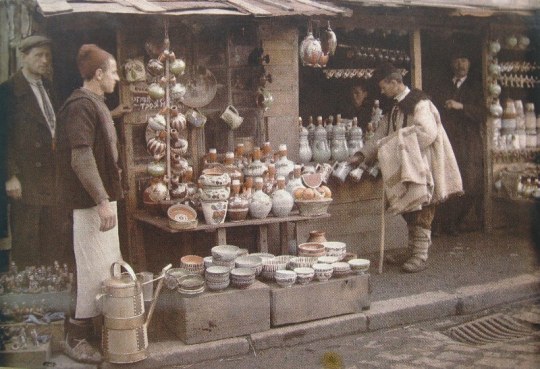
Troyan Pottery
1931
National Geographic (found and described by Penka Petrova-Goliyska, former curator at the Troyan Museum of Crafts and Applied Arts)
56 notes
·
View notes
Text
#bg lapidary gems#bg gems#bg post#bg tumblr#бг пост#bulgaria#бг блог#бг#bg#bulgarian gem crafting#gemstones#crystal gems#opals#pink opal#gems
2 notes
·
View notes
Text

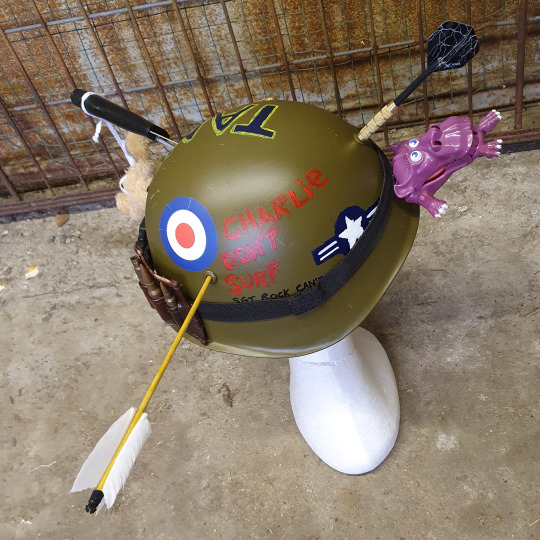
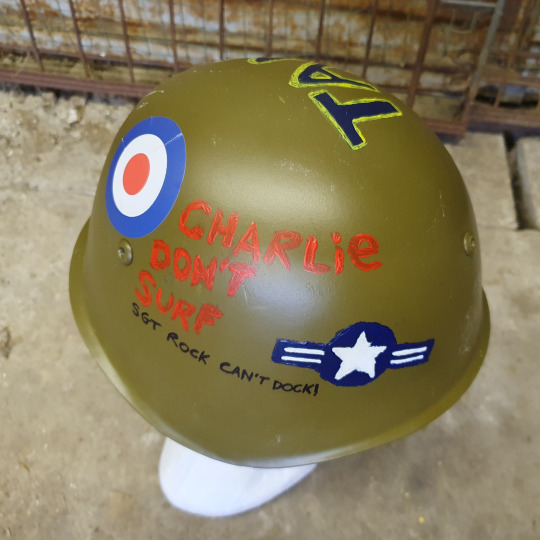
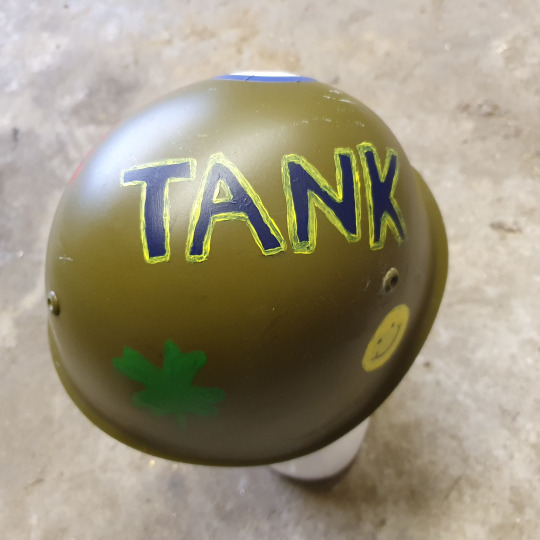
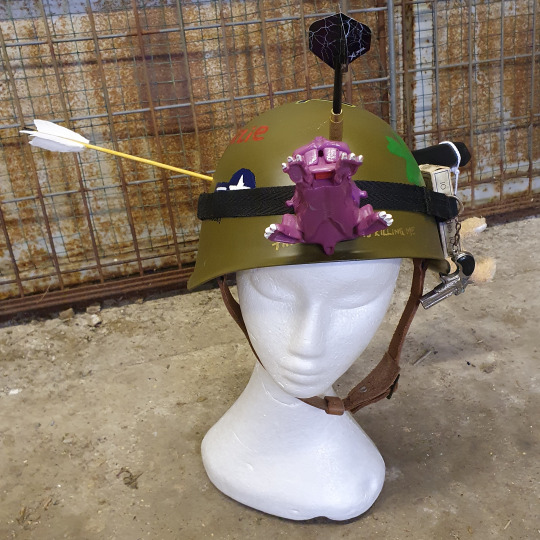

As any Tank Girl fans out there will know, our gal can often be seen wearing customised army helmets. They’re a super fun accessory, so I decided a few months back to have a go at making one. I started off by picking out a couple of ones I liked in the comics (see above for an example) and worked out a design. There were a lot of sticky out bits, so I had a feeling putting it together was going to be easier said than done, but I’ve never let that stop me before and didn’t this time. I could have taken the easy route and bought a plastic helmet, which would have been soooo simple to attach things to, but me being me, I decided to go with something authentic, namely (and I quote) a ‘genuine vintage Bulgarian army M72 steel combat helmet’ which was going cheap on good ol’ ebay 👍👍. I was totally expecting to have to drill holes in this for some of the attachments, but as luck would have it, there were some readymade ones 😊. These are the other bits I used…
1 x plastic creature head – I was looking for something which resembled the head on the attached reference picture and stumbled on something perfect while rummaging through a box of random toys in a thrift store.
1 x neodymium magnet – Used to fix the creature head onto the front of the helmet.
1 x dart – To stick in one of the holes. My only complaint here was I had to buy a pack of 3 and don’t know what to do with the other 2. Maybe I can use them in some future cosplay project.
1 x wooden rod + craft feathers + 1 x plastic wall plug – Used to make an arrow to poke in another of the holes. I had to make my own arrow, as none of the ones I saw for sale would have fit.
1 x kitchen fork – Another thrift store find which looked like it would be a good stand-in for the knife in the picture if I chopped the top off.
Some straps and buckles from an old bag – Stitched together to make a carrying strap for the helmet (which I needed to hang things off).
3 x old bullets for decoration
Some bits of leather to make a bandolier type thing to hold the bullets.
1 x old cigarette box for decoration.
1 x gun keyring – This was an impulse thrift store buy, which wasn’t in the original design, but I thought would be another good decoration (there were actually so many impulse buys like this I couldn’t use them all and ended up making a Tank Girl baseball cap for the overflow – more about that another time).
One of my old teddy bears (Flapjack) to hang from the knife (really a kitchen fork) handle.
1 x old white shoelace to make a hangman’s noose for my teddy (poor Flapjack 🎻).
Acrylic paint and brushes - I’m sure y’all can guess what these were for.
1x target sticker – I bought this in a craft store, because it looked just like the target on the helmet in the picture and I wanted to save myself a tricky painting job.
It took me a while to get all of that together (as you can imagine), but eventually I was ready to go. I eased myself in gently by sticking on the target sticker. Then I did the painting bits. I seem to be getting better at this, as I managed to get through it with no major screw-ups😊. I left the paint to dry for a day and sprayed on some fixative to protect it. It seems to be doing the job, though I have no clue how long it will last.
I made my arrow from the bits mentioned above and sawed off the top of the kitchen fork to make my stand-in knife. Then I worked out how I was going to attach everything. As I said, I used a magnet for the creature head. I stuck the arrow into one of the holes and the dart into another with a plastic bung on the other side to hold it in place. For the knife, I pushed a long screw through the last hole and screwed it into the top of the handle. You can see the screw from some angles, but it was the best I could come up with and it does the job.
I hung Flapjack from the knife handle, clipped on the carry strap with its various decorations and that’s pretty much it. It’s not a bad take on the Tank Girl originals if I do say so myself, though it takes some getting used to. I can’t tell you how many times I’ve bashed one of the sticky out bits on something when I’ve been walking around. Also it’s heavier at the back, so it has a tendency to slip off. As always, this isn’t a proper tutorial, but maybe it will be helpful if anyone out there is thinking of making their own Tank Girl helmet. Have fun if you do. I’m on Ko-fi if anyone is feeling generous and wants to support me in my cosplay adventures… ༻ko-fi.com/christabelq༺ It’s always super-appreciated. Bye for now. ❤️🧡💛💚💙💜
#tankgirl#tank girl#tankgirlcomic#cosplaygirl#cosplayers#ukcosplayer#cosplaygirls#comicbooks#follow for follow#follow back#followback#followforfollow#like for like#likeforlike#costume design#prop design#cosplay tutorial#rocket launcher#alan martin#jamie hewlett#helmet
74 notes
·
View notes
Text

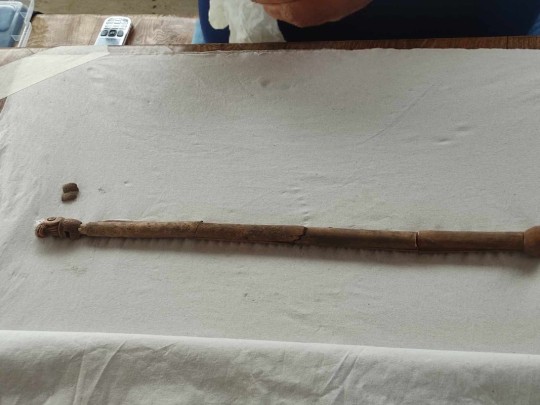
A 5th-Century BC Bone Scepter Discovered in Bulgaria
A unique bone scepter belonging to a Scythian warlord from the 5th century BC was discovered during excavations in the prehistoric salt production and urban center Provadia-Solnitsata in Northeast Bulgaria.
The Scythians were a steppe and semi-steppe people who arrived on the Danube in the seventh century BC. They entered modern-day Bulgaria, but there is no evidence that they fought the locals. There’s information that they had confrontations with the Thracians after the 5th century BC.
The archaeological team is led by Professor Vassil Nikolov. The scepter was found in a grave examined by Violeta Stoitsova and Kalina Samichkova.
Professor Vassil Nikolov told the Bulgarian News Agency (BTA) that Scythian graves are something very rare in today’s Northeastern Bulgaria are extremely rare, just four or five have been discovered so far.
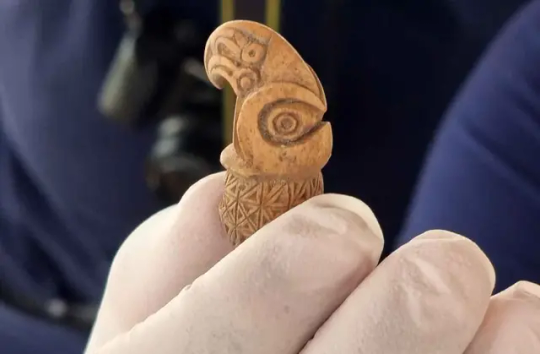
The excavated pit is different from those found so far, Nikolov explained. The shape of the Scythian warrior’s grave resembles a boot, with a hollowed-out part. It was apparently excavated in later times, but people saw the skull and upper part of the man’s skeleton, which are missing today, and stopped immediately, explained Nikolov.
Respect for ancestral graves was very important for the Scythians. Anyone who damaged one of these tombs would have harmed the Scythians. Perhaps the people who dug the grave realized that the person lying there was an important Scythian and left the grave without looting.
Archaeologists have now found the bone scepter, which the researcher described as “an incredible achievement of the art of that time”. Alongside the human bones, they also found those of a horse, an iron knife, a small dog, and a turtle.

The Scythians had exceptional traditions in the art of bone carving. The sceptre is 39 centimetres long. The handle is made of two pieces of bone glued together. The connection between the head and the handle of the scepter is very precisely crafted. Seen from one side it looks like the beak of an eagle, but on the other, the ancient craftsman has carved an anthropomorphic image on which the beak looks like a hat.
The scepter is proof of the skills of their masters, Nikolov noted and added that it probably belonged to a military commander of a small military unit.
“Those found so far are usually cruciform, with an ornithomorphic (A figure in ancient art resembling a bird) upper part. Most often the craftsmen carved an eagle because this bird is part of the Scythian religious-mythological system,” Nikolov said.
By oguz kayra.

#A 5th-Century BC Bone Scepter Discovered in Bulgaria#Provadia-Solnitsata#ancient grave#ancient tomb#ancient artifacts#archeology#archeolgst#history#history news#ancient history#ancient culture#ancient civilizations#ancient art#scythians history
48 notes
·
View notes
Text
A heated controversy erupted within Parliament following the revelation of images capturing a Christmas celebration hosted by Democratic Bulgaria. Georgi Svilensky, a member of the Bulgarian Socialist Party (BSP), unveiled photos portraying cakes shaped to resemble the Soviet Army monument, fueling intense debate and criticism.
The cakes were intricately decorated, with one displaying sugar-crafted heads and feet, symbolizing figures from the dismantled monument. The other cake depicted the monument in its original form before its removal. Svilensky condemned the event, referring to the attendees as 'the new barbarians.' Outside the parliamentary session, Ivan Chenchev from the BSP urged the resignation of all politicians involved in the controversial cake celebrations.
Earlier today, the Administrative Court in Sofia stated that the dismantling of the Soviet Army Monument lacked a legal mandate, leading to an immediate cessation as per the court's directive.
An in-depth investigation revealed that the regional administration initiated the dismantling without formal authorization, relying solely on an expert assessment and a budget allocation of BGN 260,000. These actions were undertaken without proper documentation or administrative backing, despite the monument's transition from public state property to private ownership.
This cessation resulted from a petition submitted by the pro-Russian party "Vazrazhdane" and the "Stand Up.BG" movement under Maya Manolova's leadership. In response, the regional administration intends to challenge the court's decision before the approaching Friday deadline.
Simultaneously, the Bulgarian Socialist Party (BSP) urged Chief Prosecutor Borislav Sarafov to investigate and hold accountable the regional governor and involved officials in the monument's removal.
7 notes
·
View notes
Text

Moving from the Midwestern United States to Sofia, Bulgaria is certainly an experience in cultural growth. I have found that tends to bleed into my art. Having a Bulgarian partner, joining his family, learning the language, and experiencing the traditional crafts have changed my aesthetic sensibility.
This greeting card is a combination of soft lino carvings in Bulgarian traditional textile patterns and this black heart design I have been messing with lately. Embellished with posca pens.
#block print#printmaking#card making#stamp carving#slavic art#experimental printmaking#relief print#posca pens#linocarving
15 notes
·
View notes
Note
hi! i noticed in your pinned post that you said you try to include your hungarian heritage when it comes to your craft. may i ask for some recommendations regaring this? i'm hungarian myself but everything is about catholicism these days and i couldn't really find good books about the old ways.
thank you in advance, hope you have a wonderful day!
Oof. Idk if I can really provide recommendations tbh- at least not comfortably.
This is a tricky question as I am someone who supplements much of her craft with academic literature and research. Things like anthropological studies, folkloric studies, historical papers, etc.
However, there has in fact been an ongoing reframing of history in main-stream Hungary since the 1970s, influenced by nationalist rhetoric and spurred by a romanticized view of that history started by academics as early as the late 1800s .
These academics, inspired by the current European Romantic ideology of the time, sought to uncover the "true" history of Hungary that would illuminate the pre-conquest ethnic and cultural practices of ancient Hungarians. Though there are many notable academics we can trace back to the foundation of this reframing, one of the most well known is Vilmos Diószegi.
Diószegi worked incredibly hard to prove that Hungary's spiritual history was tied to a mysterious historical figure called a 'Taltos'. It was Diószegi's belief that the 'Taltos' was a Finno-Urgic-based, Turkic style 'shaman' who assisted in priestly duties in their respective communities and used a drum to enter an ecsatcy induced trance. Diószegi would even go on to theorize what the Taltos 'shamanistic world view' would have entailed. However, many scholars, including Éva Pócs, doubt these theories and have pointed to inconsistencies in Diószegi's research and reconstruction. Though there was undoubtedly Turkic influence, these scholars suggest that the Taltos has more in common with pre-christian Balkan, Bulgarian and Southern Slavic traditions.
Now, overall there wouldn't usually be a problem with that. Disagreements happen in academia all the time. The issue is that Diószegi's work is treated as absolute, and is the basis for most modern Hungarian paganism and reconstruction due to the unique ethnic and cultural identity it can provide. A cultural identity Hungarian Nationalists love to hold up on a pedestal and point to as evidence of a glorious and mystical past that existed before Christianity and, of course, Jewish People.
Therefore, when studying Hungarian paganism and folk practices one has to be discerning. Despite Diószegi's influence on Hungarian Academia as a whole, it doesn't mean it's all without merit (it doesn't necessarily mean all of Diószegi's work is completely without merit either, just that it shouldn't be treated as gospel especially with the inconsistencies surrounding it and the romantic european foundation it was already working from). For instance Mihály Hoppál's work has been known to research not only "modern" (60's and 70's) Hungarian folk practices, but source them by region. I've learned much from his detailing of Hungarian folk practices- I just don't take everything he has to say as fact. I question it and compare it with other research- rigorously.
As for the Catholic element of Hungarian practices, my personal take is this: Embrace it. That isn't to say that you should become a Christian or even agree with Christianity. Despite the fact that I, myself, am not Christian, I personally just find it unrealistic to separate the two. Christianity has been established in Hungary since the year 1000. Over that time the 'old ways' and Christian practices have undoubtedly been syncretized past the point of being able to concretely tell them apart. This is the fundamental problem I have with reconstruction as a whole, because much of it tries to simply omit Christain concepts from folk traditions without, ironically, realizing that in doing so we may be equally erasing pre-christain approaches and philosophies. They're just too entwined. My closest ancestors were catholic as opposed to pagan. Granted, weird catholics who saw things and knew things, but catholics none the less. Their history and traditions are just as valid, and are also just as important as the pre-christian beliefs that undoubtedly found themselves braided into that same history and those same traditions.
I'm sorry if this doesn't really answer your question, but regardless I hope you found it helpful.
#answered#magic#folk magic#spirituality#hungarian folk practices#hungarian magic#not christian#christian folk practices#christian folk magic#reconstruction#history#academia
10 notes
·
View notes
Note
favorite books?
So I'm going to give you a mix of both fiction and non-fiction, anon.
So, firstly, Harry Potter. The book series of my childhood, the series that really kickstarted my obsession with writing (and my precious murder cinnamon bun, Bellatrix Lestrange, for whom I am an unrepentant simp ❤️), and the series I still have an enduring love and affection for. I'm also writing a Harry Potter fanfic on AO3!
Secondly, The Lord of the Rings and the Tolkienian legendarium. I grew up reading Tolkien and for me, Sam and Frodo and Legolas and Gandalf were part of my life like Harry Potter was. I was like... 13 when I read The Silmarillion and it really just solidified my love for Tolkien.
Agatha Christie's Murder on the Orient Express. A classic whodunnit murder-mystery and one that I keep reading every year. Hércule Poirot is the classic detective and MotOE is a brilliant story.
Ben-Gurion and the Holocaust. A very poignant and ultimately tragic examination of David Ben-Gurion during World War II by Shabtai Teveth. Most times when people write about the Shoah, they talk about the world affairs and the "important" political leaders. But Teveth explores Ben-Gurion and his desperate fight with both the UK and US governments to save as many Jews as possible.
Salonica: City of Ghosts. Salonica (also known as Thessaloniki, in modern-day Greece) was the largest center of Sephardic and Romaniote Jews in Europe, and was nicknamed "Jerusalem of the Balkans". Salonica was a Jewish majority city and was an ethnically cosmopolitan city — Jews, Egyptians, Greeks, Turks, Albanians, Armenians, Bulgarians, Syrians, among others. And this wonderful city became a city of ghosts when the Germans invaded in World War II. It's recovered, of course, but not to where it once was.
Maus. While it's a graphic novel rather than an actual book, this is one of the most important Shoah novels that people should read (along with Night by Elie Wiesel z"l). Art Spiegelman crafts an incredible and heartbreaking and gripping interview of Art's father who survived Auschwitz.
2 notes
·
View notes
Text

2023/08/03
Hicimos una parada para beber. Como no nos gusta la cerveza, pedimos sidra artesanal. Echamos de menos la costumbre española de acompañar la bebida con unas aceitunas o unas patatas fritas.
We stopped for a drink. Since we don't like beer, we ordered craft cider. We miss the Spanish custom of accompanying the drink with some olives or some chips.
Google Translation into French:
Nous nous sommes arrêtés pour boire un verre. Comme nous n'aimons pas la bière, nous avons commandé du cidre artisanal. La coutume espagnole d'accompagner la boisson de quelques olives ou de quelques chips nous manque.
Google translation into Italian:
Ci siamo fermati per un drink. Dato che non ci piace la birra, abbiamo ordinato del sidro artigianale. Ci manca l'usanza spagnola di accompagnare la bevanda con qualche oliva o qualche patatine.
Google Translation into Portuguese:
Paramos para tomar uma bebida. Como não gostamos de cerveja, pedimos cidra artesanal. Sentimos falta do costume espanhol de acompanhar a bebida com umas azeitonas ou algumas batatas fritas.
Google Translation into German:
Wir machten eine Pause, um etwas zu trinken. Da wir kein Bier mögen, haben wir Craft Cider bestellt. Wir vermissen den spanischen Brauch, zu dem Getränk ein paar Oliven oder Chips zu servieren.
Google Translation into Albanisch:
U ndalëm për një pije. Meqenëse nuk na pëlqen birra, porositëm mushtin e artizanatit. Na mungon zakoni spanjoll për të shoqëruar pijen me disa ullinj ose disa patatina.
Google Translation into Armenian:
Մենք կանգ առանք խմելու։ Քանի որ մենք գարեջուր չենք սիրում, պատվիրեցինք արհեստական խնձորօղի։ Մենք կարոտում ենք խմիչքը ձիթապտուղներով կամ չիփսերով ուղեկցելու իսպանական սովորույթին:
Google Translation into Bulgarian:
Спряхме да пийнем. Тъй като не обичаме бира, поръчахме крафт сайдер. Пропускаме испанския обичай да придружаваме напитката с малко маслини или малко чипс.
Google Translation into Czech:
Zastavili jsme se na drink. Protože nemáme rádi pivo, objednali jsme si craft cider. Chybí nám španělský zvyk doprovázet nápoj olivami nebo chipsy.
Google Translation into Croatian:
Stali smo na piće. Kako ne volimo pivo, naručili smo craft cider. Nedostaje nam španjolski običaj da uz piće dodamo malo maslina ili čipsa.
Google Translation into Danish
Vi stoppede for en drink. Da vi ikke kan lide øl, bestilte vi håndværkscider. Vi savner den spanske skik med at ledsage drinken med nogle oliven eller nogle chips.
Google Translation into Slovak:
Zastavili sme sa na drink. Keďže nemáme radi pivo, objednali sme si remeselný cider. Chýba nám španielsky zvyk sprevádzať nápoj olivami alebo hranolkami.
Google Translation into Slovenian:
Ustavila sva se na pijači. Ker ne marava piva, sva naročila craft cider. Pogrešamo špansko navado, da pijačo pospremimo z olivami ali čipsom.
Google Translation into Estonian:
Peatusime jooma. Kuna meile õlu ei maitse, siis tellisime käsitöösiidri. Tunneme puudust hispaanlaste tavast, et joogi kõrvale pakume oliive või krõpse.
Google Translation into Suomi:
Pysähdyimme juomaan. Koska emme pidä oluesta, tilasimme käsityösiiderin. Kaipaamme espanjalaista tapaa lisätä juoman mukana oliiveja tai siruja.
Google Translation into Georgian:
სასმელისთვის გავჩერდით. რადგან ლუდი არ გვიყვარს, კრაფტ სიდრი შევუკვეთეთ. ჩვენ გვენატრება ესპანეთის ჩვეულება, რომელიც სასმელს ზეთისხილით ან ჩიფსით ვაყოლებთ.
Google Translation into Greek:
Σταματήσαμε για ένα ποτό. Επειδή δεν μας αρέσει η μπύρα, παραγγείλαμε craft μηλίτη. Μας λείπει το ισπανικό έθιμο να συνοδεύουμε το ποτό με μερικές ελιές ή μερικά πατατάκια.
Google Translation into Hungarian:
Megálltunk egy italra. Mivel nem szeretjük a sört, kézműves almabort rendeltünk. Hiányoljuk azt a spanyol szokást, hogy olajbogyóval vagy chipsszel kísérjük az italt.
Google Translation into Latvian:
Mēs apstājāmies, lai iedzertu. Tā kā mums negaršo alus, tad pasūtījām craft sidru. Mums pietrūkst spāņu paraduma dzērienu pavadīt ar olīvām vai čipsiem.
Google Translation into Dutch:
We stopten voor een drankje. Omdat we niet van bier houden, hebben we ambachtelijke cider besteld. Wij missen de Spaanse gewoonte om de borrel te begeleiden met wat olijven of wat friet.
Google Translation into Norwegian:
Vi stoppet for en drink. Siden vi ikke liker øl, bestilte vi håndverkscider. Vi savner den spanske skikken med å ledsage drinken med litt oliven eller chips.
Google Translation into Polish:
Zatrzymaliśmy się na drinka. Ponieważ nie lubimy piwa, zamówiliśmy cydr rzemieślniczy. Tęsknimy za hiszpańskim zwyczajem dodawania do drinka oliwek lub chipsów.
Google Translation into Romanian:
Ne-am oprit să bem ceva. Pentru că nu ne place berea, am comandat cidru artizanal. Ne lipsește obiceiul spaniol de a însoți băutura cu niște măsline sau niște chipsuri.
Google Translation into Russian:
Мы остановились выпить. Так как пиво мы не любим, то заказали крафтовый сидр. Нам не хватает испанского обычая сопровождать напиток оливками или чипсами.
Google Translation into Serbian:
Стали смо на пиће. Пошто не волимо пиво, наручили смо занатску јабуковачу. Недостаје нам шпански обичај да се пиће попрати са маслинама или чипсом.
Google Translation into Swedish:
Vi stannade för en drink. Eftersom vi inte gillar öl beställde vi hantverkscider. Vi saknar den spanska seden att åtfölja drinken med några oliver eller några chips.
Google Translation into Turkish:
Bir içki için durduk. Bira sevmediğimiz için el yapımı elma şarabı sipariş ettik. İçeceğe biraz zeytin ya da biraz cips eşlik eden İspanyol geleneğini özlüyoruz.
Google Translation into Ukrainian:
Ми зупинилися випити. Оскільки ми не любимо пиво, то замовили крафтовий сидр. Ми сумуємо за іспанським звичаєм супроводжувати напій оливками або чіпсами.
Google Translation into Arabic:
توقفنا لتناول مشروب. وبما أننا لا نحب البيرة، طلبنا عصير التفاح الحرفي. نحن نفتقد العادة الإسبانية المتمثلة في مرافقة المشروب مع بعض الزيتون أو بعض رقائق البطاطس.
Google Translation into Bengali:
আমরা মদ্যপানের জন্য থামলাম। যেহেতু আমরা বিয়ার পছন্দ করি না, তাই আমরা ক্রাফ্ট সাইডার অর্ডার করেছি। আমরা কিছু জলপাই বা কিছু চিপস সঙ্গে পানীয় সহগামী স্প্যানিশ রীতি মিস.
Google Translation into Simplified Chinese:
我们停下来喝了一杯。 由于我们不喜欢啤酒,所以我们点了精酿苹果酒。 我们怀念西班牙的习俗,即在饮料中配上一些橄榄或薯条。
Google Translation into Korean:
우리는 술을 마시려고 멈춰 섰다. 저희는 맥주를 좋아하지 않아서 수제사이다를 주문했어요. 우리는 음료에 올리브나 칩을 곁들여 먹는 스페인의 관습을 그리워합니다.
Google Translation into Guarani:
Ropyta royʼu hag̃ua. Ndoroguerohorýigui cerveza, roordena sidra artesanal. Ñande japerde pe jepokuaa española omoirûva pe bebida unos kuánto oliva térã unos cuantos chipa reheve.
Google Translation into Hawaiian:
Kū mākou e inu. No ka mea ʻaʻole mākou makemake i ka pia, ua kauoha mākou i ka cider craft. Ua hala mākou i ka hana maʻamau o Sepania e hele pū me ka inu me kekahi mau ʻoliva a i ʻole kekahi mau ʻōpala.
Google Translation into Hebrew:
עצרנו לשתות משהו. מכיוון שאנחנו לא אוהבים בירה, הזמנו סיידר מלאכה. אנחנו מתגעגעים למנהג הספרדי של ללוות את המשקה עם קצת זיתים או קצת צ'יפס.
Google Translation into Hindi:
हम ड्रिंक के लिए रुके. चूँकि हमें बीयर पसंद नहीं है, इसलिए हमने क्राफ्ट साइडर का ऑर्डर दिया। हम पेय के साथ कुछ जैतून या कुछ चिप्स डालने की स्पेनिश परंपरा को याद करते हैं।
Google Translation into Indonesian:
Kami berhenti untuk minum. Karena kami tidak suka bir, kami memesan sari buah apel. Kami merindukan kebiasaan Spanyol yang menemani minuman dengan buah zaitun atau keripik.
Google Translation into Japanese:
私たちは飲み物を飲みに立ち寄りました。 私たちはビールが苦手なのでクラフトサイダーを注文しました。 飲み物にオリーブやポテトチップスを添えるスペインの習慣が懐かしいです。
Google Translation into Kyrgyz:
Ичүү үчүн токтодук. Биз пивону жактырбагандыктан, сидрге заказ бердик. Суусундукту зайтун же чипсы менен коштогон испан салтын сагындык.
Google Translation into Malayalam:
ഞങ്ങൾ മദ്യപിക്കാൻ നിന്നു. ബിയർ ഇഷ്ടമല്ലാത്തതിനാൽ ക്രാഫ്റ്റ് സൈഡർ ഓർഡർ ചെയ്തു. പാനീയത്തിനൊപ്പം കുറച്ച് ഒലീവ് അല്ലെങ്കിൽ കുറച്ച് ചിപ്സ് കഴിക്കുന്ന സ്പാനിഷ് ആചാരം ഞങ്ങൾ നഷ്ടപ്പെടുത്തുന്നു.
Google Translation into Malay:
Kami berhenti untuk minum. Oleh kerana kami tidak suka bir, kami memesan cider kraf. Kami merindui adat Sepanyol untuk mengiringi minuman dengan beberapa buah zaitun atau beberapa kerepek.
Google Translation into Malagasy:
Nijanona nisotro izahay. Koa satria tsy tia labiera izahay dia nanafatra cider craft. Malahelo ny fomban'ny Espaniola miaraka amin'ny zava-pisotro miaraka amin'ny oliva na poti.
Google Translation into Mongolian:
Бид уухаар зогсов. Бид шар айрагнд дургүй болохоор гар урлалын алим захиалсан. Чидун жимс эсвэл чипстэй ундаа дагалддаг Испанийн заншлыг бид санаж байна.
Google Translation into Nepali:
हामी रक्सी खान रोकियौं। हामीलाई बियर मन नपर्ने हुनाले हामीले क्राफ्ट साइडर अर्डर गर्यौं। हामीले केही जैतून वा केही चिप्सको साथ पेयको साथमा स्पेनिस चलनलाई याद गर्छौं।
Google Translation into Panjabi:
ਅਸੀਂ ਪੀਣ ਲਈ ਰੁਕ ਗਏ। ਕਿਉਂਕਿ ਸਾਨੂੰ ਬੀਅਰ ਪਸੰਦ ਨਹੀਂ ਹੈ, ਅਸੀਂ ਕਰਾਫਟ ਸਾਈਡਰ ਦਾ ਆਰਡਰ ਦਿੱਤਾ ਹੈ। ਅਸੀਂ ਕੁਝ ਜੈਤੂਨ ਜਾਂ ਕੁਝ ਚਿਪਸ ਦੇ ਨਾਲ ਪੀਣ ਦੇ ਨਾਲ ਸਪੈਨਿਸ਼ ਰਿਵਾਜ ਨੂੰ ਯਾਦ ਕਰਦੇ ਹਾਂ.
Google Translation into Pashtun:
موږ د څښاک لپاره ودرید. څرنګه چې موږ بیر نه خوښوو، موږ د کرافټ سایډر امر وکړ. موږ د ځینې زیتون یا ځینې چپس سره د څښاک سره د هسپانوي دود له لاسه ورکوو.
Google Translation into Persian:
برای نوشیدنی توقف کردیم. از آنجایی که ما آبجو دوست نداریم، سیدر کرافت سفارش دادیم. ما دلتنگ رسم اسپانیایی همراهی نوشیدنی با مقداری زیتون یا چیپس هستیم.
Google Translation into Sundanese:
Urang dieureunkeun keur inuman. Kusabab urang henteu resep bir, kami mesen cider karajinan. Kami sono kana adat Spanyol anu ngiringan inuman sareng sababaraha zaitun atanapi sababaraha chip.
Google Translation into Tagalog:
Huminto kami para uminom. Dahil hindi kami mahilig sa beer, umorder kami ng craft cider. Nami-miss namin ang kaugalian ng Espanyol na samahan ang inumin na may ilang olibo o ilang chips.
Google Translation into Thai:
เราหยุดเพื่อดื่ม เนื่องจากเราไม่ชอบเบียร์ เราจึงสั่งคราฟต์ไซเดอร์ เราคิดถึงธรรมเนียมของชาวสเปนในการดื่มคู่กับมะกอกหรือมันฝรั่งทอด
Google Translation into Telugu:
మేము పానీయం కోసం ఆగిపోయాము. మాకు బీర్ ఇష్టం లేదు కాబట్టి క్రాఫ్ట్ సైడర్ ఆర్డర్ చేశాం. పానీయంతో పాటు కొన్ని ఆలివ్లు లేదా కొన్ని చిప్స్తో కూడిన స్పానిష్ ఆచారాన్ని మేము కోల్పోతాము.
Google Translation into Urdu:
ہم پینے کے لیے رک گئے۔ چونکہ ہمیں بیئر پسند نہیں، ہم نے کرافٹ سائڈر کا آرڈر دیا۔ ہم کچھ زیتون یا کچھ چپس کے ساتھ مشروب کے ساتھ ہسپانوی رواج کو یاد کرتے ہیں۔
Google Translation into Uzbek:
Biz ichish uchun to'xtadik. Biz pivoni yoqtirmasligimiz uchun hunarmand sidriga buyurtma berdik. Biz ispanlarning ichimlikni zaytun yoki chips bilan birga qo'shish odatini sog'inamiz.
Google Translation into Vietnamese:
Chúng tôi dừng lại để uống. Vì chúng tôi không thích bia nên chúng tôi đã gọi rượu táo thủ công. Chúng tôi nhớ phong tục của người Tây Ban Nha là dùng kèm đồ uống với một ít ô liu hoặc một ít khoai tây chiên.
#Bruselas#Bruxelles#Brussels#Belgica#Belgium#Stop#Drink#Bar#Terrace#Artisan#Cider#Ruwet#PolloNegroSkyWalker#TravelBlogger#Wanderlust#CoupleGoals#GoodVibes#Plushies#instaGood#Maharashtra#ペンギン
5 notes
·
View notes
Audio
Title: Sleepy Hollow
Artist: SubSonic
Label: "No sleep till bedtime..."⠀
Format: Digital
Release: August 27th 2023
Track list:
01] Sleepy Hollow
Link: https://nosleeptillbedtime.bandcamp.com/track/sleepy-hollow
For [nstbt_030] we have another HUGE single track release!
This one comes from Bulgarian hard techno producer: SubSonic
Subsonic is a self-taught music composer, who is known for his productions throughout various musical genres such as: electronic, techno, hard techno, schranz, classical, cinematic trailer music and film.
He is always releasing a steady stream of original music, tutorials and hand crafted sample packs via his label: https://darknessfallsrecordings.com/
Subsonic is both highly creative, and highly motivated.
His sample packs alone are some of the best we've ever heard for the genre, combining both unique field recordings and expertly crafted sound design. You will be sure to find new inspiration to add to your productions, or even a good starting point when starting from scratch.
Subsonic was also a part of our 'Endure and survive' various artists release from a few years ago, submitting one of his highly energetic hard techno tracks: https://nosleeptillbedtime.bandcamp.com/album/endure-and-survive
Sleepy Hollow is no different, a combination of heavy percussion, with a building melodic hook and swelling bass line. It builds itself up and then drops you into a state of pure ecstasy.
I know we say this all the time, but we are grateful to be able to work with so many talented artists, and to be able to share their music and stories with you all.
You can learn more and show him some support by following his pages listed below 👇🏻
Thank you Angel! 🙏🏻😁
[subsonic_pages]
Instagram: https://www.instagram.com/subsonic_hardtechno/
Facebook: https://www.facebook.com/subsonichardtechno
Patreon: https://www.patreon.com/DarknessFallsRecordings
Website: https://darknessfallsrecordings.com/
Mastering by: Mickey Nox
[nstbt_pages]
Website: http://www.nosleeptillbedtime.net
Facebook: https://www.facebook.com/nosleeptillbedtime/
Instagram: https://www.instagram.com/nstbt_melb/
#hardtechno #schranz #techno #bulgaria #industrialhardcore #industrialtechno #producer #undergroundtechno #ilovetechno #artist #technorave #bass #darktechno #rave #hardcore #technomusic #underground #hardtechnoDJ #industrialhardtechno #acidtechno #hardtechnomusic #raver #dj
(6head_slug)
2 notes
·
View notes
Text






Busintsi Pottery
The Museum of Busintsi Pottery
Busintsi, Trun municipality, Bulgaria
There are three major schools of Bulgarian pottery - pottery from Troyan, Veliko Tarnovo and Busintsi. The three styles of pottery are made using different techniques, forms and ornaments. The pottery from Busintsi is the least well-known of the three styles and there are very few modern craftsmen skilled in this style of pottery.
Busintsi pottery is distinctive for its complex forms and its comparatively simple decoration. The "Busintsi green" used to colour the glaze sets it apart from other Bulgarian pottery. Other typical colours include yellow and dark red. Busintsi pottery was made from local clay, and the craftsmen used local metal and plants to create the bright colours of the glaze. Small pitchers for wine and rakia, richly decorated with figures, called "okantsi" (оканци) are typical for this style of pottery and were used when inviting guests to weddings.
During the Bulgarian Enlightenment (18 - 19th centuries) pottery became central to the economy of Busintsi, reaching a total of over 300 workshops with 1500 craftsmen. The craft began to spread to neighbouring towns of Samokov, Berkovitsa, Razlog and Nevrokop. Towards the end of the 19th century, Busintsi is described in Konstantin Jireček's "Travels through Bulgaria" as the centre of a very particular pottery industry, which uses very old forms and ornaments. The pottery industry in Busintsi began to decline with the advent of industrialisation, despite efforts to modernise it. One of the last prominent masters of the craft was Petar Gigov, who was instrumental in the founding of the Museum of Busintsi Pottery in 1982.
The Gigov workshop is still active and can be found opposite the museum, and there are efforts to revitalise the craft.
#bulgaria#Bulgarian pottery#The Bulgarian Pottery series#Pottery#Busintsi pottery#Eastern europe#Crafts#Petar Gigov was a very interesting man and deserves a post of his own
46 notes
·
View notes
Text
Първи опит, за собственоръчна изработка, на амулет от кварц.
АМУЛЕТИ
"Амулетите и кристалите са будните сред спящи. Те ни пазят и помагат, когато ние сами не можем." мъдрост от вековете.
От векове амулетите, талисманите и минералите вършат чудеса. В ръцете на своя собственик те могат да оказват мощно положително въздействие върху психическото му състояние, подпомагайки разрешаването на различни проблеми. Всеки знак представлява фокусирани знания, преобразувани в енергия през вековете на човешкото развитие. Във Варненското съкровище датирано 6000 г. пр. н. е. има украшения, очевидно ползвани като амулети. Намерените артефакти от епохата на неолита са именно амулети. Сами по себе си амулетите, и кристалите са пасивна защита. Съчетанието на мисловната енергия на човека с амулета или кристала има мощно положително въздействие.





#bg post#bg tumblr#bulgaria#бг пост#бг#бг блог#bg#bg text#бг автор#бг минерали#bulgarian gem crafting#bulgarian lapidary#bulgarian faceting#bg faceting gems#bg lapidary gems#bg author
2 notes
·
View notes
Text
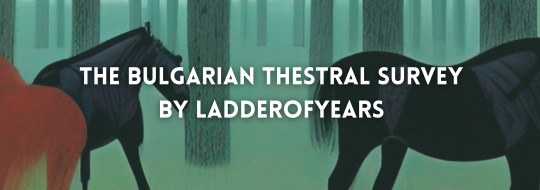
The Bulgarian Thestral Survey by Ladderofyears
Summary:
Selected excerpts from Draco's journal, written whilst observing Thestrals in Bulgaria.
Link to Fic: https://archiveofourown.org/works/43224981/chapters/108641850
My Thoughts: Though this is a compact fic, it is brimming with love and tenderness! I love how each entry is so carefully crafted in Draco’s and give us a peek into his life with Harry. So sweet! So good!
5 notes
·
View notes
Note
💭 + her parents
𝓗𝓮𝓪𝓭𝓬𝓪𝓷𝓸𝓷𝓼 — send 💭 + a topic to receive a headcanon about said topic.

Katherine had a complicated relationship with her parents. Growing up in the late 1400's there wasn't much she could do about it either. (At least not as a woman)
Katerina Katherine's father was a horrible man, he was a drunkard and abusive both physically and mentally towards her and her mother and sister. He rarely addressed any of them by name, his wife was most often just called "Woman" and his daughters were just "Girl" because they were not really people to him. (Even if he didn't realize that was essentially what that was.)
He was incredibly judgemental all across the board and highly misogynistic. It all got worse when he was drunk. He'd find any reason to yell at them, throw things, push them around. As much as she wanted to, Katerina's Katherine's mother couldn't protect the girls. It would only get worse when she tried to sooth him, and eventually Katherine just asked her mother to stop. Heartbreakingly enough she was 9 when that took place. Katherine was fighting for her survival from a very young age, that did not show up over night in 1492. Katherine has been in a state of fight or flight since she was a very small child.
Things only got worse when Katherine met a young man of the traveler subclass. Her father lost his shit and forbayed her from seeing him. Screamed at her about how she was to have nothing to do with anyone of the traveler sort and to stay far away from the devil's craft. Unfortunately he could not stop him from seeking out his daughter, and he was just the sort of charming to sweep her off her feet. Just as Katherine's father had been to her mother. (we accept the love with think we deserve- so good going daddy dearest)
That wolf in sheeps clothing manipulated her just like her father and ultimately was how she ended up unwed with child- and her father sending her into exile after disgracing the family.
On the other hand, Katerina's Katherine's relationship with her mother was much different. Her mother was her hero, her favourite person in the whole world. She loved her mother with all of her heart and her mother loved her much the same. It's actually her mother who taught her how to love so deeply and fully. She raised her on fairy tales of romances that transcend time, and endless love.
Her mother taught her to sing, her mother taught her to cook, her mother taught her how to sew and mend her clothing, and in some ways her mother taught her how to endure red flags for the sake of 'love'.
Katherine's mother was the most important person in the world to her. Being sent into exile was heart breaking for both of them, but her mother sent her away with a ring that she'd always intended to pass onto her first born daughter. A family heirloom, a ring with a tiny sapphire gem stone. It is the one thing Katherine has consistently kept all 500 years in her running, the one thing shes never lost.
Finding her mother slaughtered by Klaus was possibly the most traumatic experience of her life, and one of the biggest guilts shes carried on her shoulders for centuries. She still has nightmares about it. Sometimes, she cries in her sleep, and if you listen closely you can make out her whimpers to occasionally be 'мамо моля те! Мамо, съжалявам!' Elijah has heard this several times, and Stefan has as well, but Stefan doesn't speak Bulgarian so there's no way he would know.
If you ask Katherine "If you could bring back one person from the dead for 24 hours to see and talk to who would it be?" Her answer would always be "мама."
#answered#headcanon#THIS GOT LONG AGAIN IM SO SORRY HHHHHH#when will i answer a HC without writing a novel?#abuse tw
2 notes
·
View notes
Photo

Secret Nationalization Process in Bulgaria
The Start of Nationalization
Preparations for the nationalization of businesses in Bulgaria were conducted in complete secrecy. On December 22, 1947, even before the new Nationalization Bill was officially passed, the communists began expropriating businesses. This process was made deliberately simple: business owners were instructed to hand over the keys to their offices and safes to representatives of the Communist Party who suddenly appeared at their doorsteps.
The Expropriation Process
Once the keys were handed over, the owner had to sign a statement declaring that they were submitting their business to the “people’s government.” After this, they were allowed to leave, often just taking their coat. Meanwhile, factory loudspeakers announced that the government had decided to expropriate that particular business. This sudden and harsh action removed owners from their positions in industrial, banking, and trade enterprises.
The repercussions of this process were severe. Not only were the owners stripped of their working capital and bank deposits, but they also lost most of their personal property, including houses, jewelry, cars, and other belongings Istanbul Tour Guides.
Nationalization of the Banking Sector
On December 25, 1947, a Bill was passed that imposed a state monopoly over banking. As a result, 31 Bulgarian and foreign banks were nationalized. This move eliminated any remaining aspects of a market economy in Bulgaria. Instead, a new bureaucratic economy took its place, leaving no room for entrepreneurship. Management of the enterprises was handed over to party activists, who often lacked the necessary skills to run businesses effectively.
The End of Private Enterprise
By this time, not a single private enterprise was left in Bulgaria. There were no privately owned small craft shops or any other types of shops remaining. The sweeping nature of the nationalization marked a significant shift in the country’s economic landscape, effectively ending the era of private ownership.
Impact on Housing and Citizens
The campaign of expropriation extended beyond businesses to include the homes of certain citizens. During 1948, housing committees set up by the municipal councils began relocating owners of urban properties. They would often house Communist Party functionaries and loyal employees in the flats or houses of those labeled as “enemies of the people.” This included relatives of individuals who had been sent to labor camps, executed, or interned.
The Urban House Property Bill
The Bill for Urban House Property provided for the complete or partial expropriation of homes, flats, villas, and offices belonging to well-off citizens. This further exemplified the regime’s efforts to consolidate power and eliminate any remnants of private ownership in society.
The nationalization process in Bulgaria was marked by secrecy, force, and the complete eradication of private ownership. The impact on individuals and businesses was devastating, leading to a bureaucratic economy that stifled entrepreneurship and innovation. The government’s actions fundamentally transformed Bulgarian society and its economy, creating lasting effects that would shape the nation for years to come.
0 notes
Photo

Secret Nationalization Process in Bulgaria
The Start of Nationalization
Preparations for the nationalization of businesses in Bulgaria were conducted in complete secrecy. On December 22, 1947, even before the new Nationalization Bill was officially passed, the communists began expropriating businesses. This process was made deliberately simple: business owners were instructed to hand over the keys to their offices and safes to representatives of the Communist Party who suddenly appeared at their doorsteps.
The Expropriation Process
Once the keys were handed over, the owner had to sign a statement declaring that they were submitting their business to the “people’s government.” After this, they were allowed to leave, often just taking their coat. Meanwhile, factory loudspeakers announced that the government had decided to expropriate that particular business. This sudden and harsh action removed owners from their positions in industrial, banking, and trade enterprises.
The repercussions of this process were severe. Not only were the owners stripped of their working capital and bank deposits, but they also lost most of their personal property, including houses, jewelry, cars, and other belongings Istanbul Tour Guides.
Nationalization of the Banking Sector
On December 25, 1947, a Bill was passed that imposed a state monopoly over banking. As a result, 31 Bulgarian and foreign banks were nationalized. This move eliminated any remaining aspects of a market economy in Bulgaria. Instead, a new bureaucratic economy took its place, leaving no room for entrepreneurship. Management of the enterprises was handed over to party activists, who often lacked the necessary skills to run businesses effectively.
The End of Private Enterprise
By this time, not a single private enterprise was left in Bulgaria. There were no privately owned small craft shops or any other types of shops remaining. The sweeping nature of the nationalization marked a significant shift in the country’s economic landscape, effectively ending the era of private ownership.
Impact on Housing and Citizens
The campaign of expropriation extended beyond businesses to include the homes of certain citizens. During 1948, housing committees set up by the municipal councils began relocating owners of urban properties. They would often house Communist Party functionaries and loyal employees in the flats or houses of those labeled as “enemies of the people.” This included relatives of individuals who had been sent to labor camps, executed, or interned.
The Urban House Property Bill
The Bill for Urban House Property provided for the complete or partial expropriation of homes, flats, villas, and offices belonging to well-off citizens. This further exemplified the regime’s efforts to consolidate power and eliminate any remnants of private ownership in society.
The nationalization process in Bulgaria was marked by secrecy, force, and the complete eradication of private ownership. The impact on individuals and businesses was devastating, leading to a bureaucratic economy that stifled entrepreneurship and innovation. The government’s actions fundamentally transformed Bulgarian society and its economy, creating lasting effects that would shape the nation for years to come.
0 notes